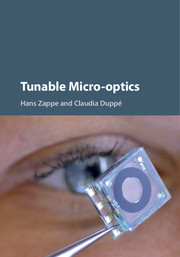Book contents
- Frontmatter
- Dedication
- Contents
- List of contributors
- List of acronyms
- Part I Introduction
- Part II Devices and materials
- 3 Soft-Matter Micro-optics
- 4 Tunable Reflective Optics
- 5 Tunable Liquid Lenses
- 6 Optofluidic Micro-shutters and Micro-irises
- 7 Solid Body Elastomeric Lenses
- 8 Spatially Tunable Polarization Devices
- 9 Aluminum Nitride and Diamond Membranes for Tunable Micro-optics
- 10 Piezoelectrically Actuated Tunable Microlenses
- Part III Systems and Applications
- Index
- References
3 - Soft-Matter Micro-optics
from Part II - Devices and materials
Published online by Cambridge University Press: 05 December 2015
- Frontmatter
- Dedication
- Contents
- List of contributors
- List of acronyms
- Part I Introduction
- Part II Devices and materials
- 3 Soft-Matter Micro-optics
- 4 Tunable Reflective Optics
- 5 Tunable Liquid Lenses
- 6 Optofluidic Micro-shutters and Micro-irises
- 7 Solid Body Elastomeric Lenses
- 8 Spatially Tunable Polarization Devices
- 9 Aluminum Nitride and Diamond Membranes for Tunable Micro-optics
- 10 Piezoelectrically Actuated Tunable Microlenses
- Part III Systems and Applications
- Index
- References
Summary
This chapter discusses the use of soft condensed matter for the development of novel fabrication and tuning concepts for optical microsystems. With its characteristic optical effects, soft matter offers a large potential in the areas of functionality, fabrication, and assembly in microsystems engineering. The physical basis is the scaling behavior of the interactions involved in such systems. With regard to micro-optics in particular, researchers and engineers have shown considerable creativity in designing and demonstrating microsystems with soft matter in their function-relevant components, leading to a broad number of surprising and successful approaches to tunable, variable, active, or adaptive micro-optical systems.
We will thus focus on soft-matter-based approaches to active micro-optical systems and provide an overview of material that is well suited for tunable micro-optics, for example liquids and polymers. The ensuing sections discuss micro-optical systems based on wetting and elasticity, which represent two important classes of effects that are typical for soft matter. In the last section, we will summarize and conclude the topic from an industrial point of view.
Introduction
At first glance, optics and soft condensed matter do not seem to have much in common: since optics is primarily associated with glass components and precision manufacturing, this naive association excludes liquids and elastic solids as optical materials. A closer investigation, however, reveals several interesting links between these fields. Historical experiments of the nineteenth century by the Swiss physicist Daniel Colladon used water jets to demonstrate light guiding, or illumination effects for aesthetic purposes making use of dyed water in glass vessels. The optical effects generated by water droplets can be observed in our daily lives. Such examples motivate us to take a closer look at soft condensed matter, its characteristic effects, and its applications (both existing and emerging) in micro-optics.
The term soft condensed matter comprises a broad variety of very different materials and excludes gases, plasmas, and crystalline, hard, brittle, mostly inorganic solids, such as ceramics, metals, semiconductors, and dielectric crystals, which are treated in a typical university course of solid state physics. Many of the materials not treated there fall within the domain of soft matter, among them liquids, polymers, colloids, liquid crystals, composites, and biological matter, all of which consist of, or contain, organic molecules as their major constituents.
- Type
- Chapter
- Information
- Tunable Micro-optics , pp. 67 - 91Publisher: Cambridge University PressPrint publication year: 2015



